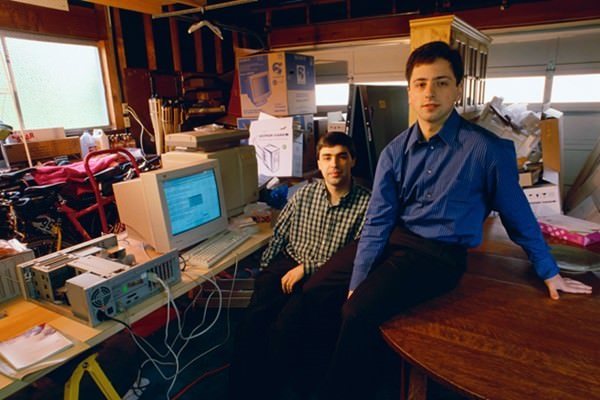When Larry and Sergey first met, they didn’t like each other much.
In the summer of 1995, Larry Page was considering a transfer to Stanford University’s graduate program in Computer Science. Sergey Brin was already two years into the program, and he had signed up to be a tour guide of sorts to potential students. One summer day he showed Page and a group of other potential Stanford students around the Bay Area.
“I thought he was pretty obnoxious,” Page said later of his guide. “He had really strong opinions about things and I guess I did, too.”
“We both found each other obnoxious,” Brin agrees. And yet, it wasn’t hatred, exactly, as much as it was the coming together of two strong, fiercely proud intellects. They might have stepped on each other’s toes a bit, but at the same time there was a degree of frisson to the encounter. “We spent a lot of time talking to each other,” Brin would recall, “so there was something there. We had a kind of bantering thing going.”
On the surface, it might not have seemed like Page and Brin had anything in common. Page was Midwestern, born in East Lansing, Michigan on March 26, 1973. Brin was born in Moscow, in the iron-curtain-era USSR, on August 21, 1973, only emigrating to the United States when he was six years old. Page was reserved, quiet, contemplative. Brin was outgoing, gregarious, loud. Page was a deep thinker, a visionary. Brin, a problem solver, an engineer’s engineer.
But the two had more in common than anyone knew that first day. For one thing, they both came from academic families. Page’s father was a pioneering Computer Science professor at Michigan State University, where his mother was also a computer programming instructor. Brin’s father was a mathematics professor at the University of Maryland and his mother a researcher at NASA’s Goddard Space Flight Center. Larry and Sergey both grew up to respect research, academic study, mathematics and, especially, computers. And it turned out they both had inquisitive minds that believed in the power of knowledge to overcome any obstacle, intellectual or practical. Each had been inculcated into this spirit of intellectual fearlessness at a young age.
LarryAndSergey
“You can’t understand Google,” early Google employee Marissa Mayer has insisted, “unless you know that both Larry and Sergey were Montessori kids. It’s really ingrained in their personalities. To ask their own questions, do their own things. Do something because it makes sense, not because some authority figure told you. In a Montessori school, you go paint because you have something to express or you just want to do it that afternoon, not because the teacher said so. This is baked into how Larry and Sergey approach problems. They’re always asking, why should it be like that? It’s the way their brains were programmed early on.”
For Larry and Sergey, their intellectual fearlessness overlapped in such a way that their conflicting personalities actually ended up complimenting each other. When Page joined Stanford for the 95/96 academic year, he and Brin became close. Friends took to calling the duo LerryandSergey, suggesting they were somewhat inseparable. The pair would end up debating endlessly on topics ranging from philosophy to computing to films, two equally-matched polymaths thrilling to the intellectual joust. Brin’s hobby project was creating a software program that could provide movie recommendations based on the tastes and viewing habits of other people who had seen similar films (sounds not unlike what Netflix later perfected). Page’s dream obsession was creating a system of networked, autonomous cars to ferry people around (so it’s probably no coincidence that Google is working on driverless cars today).
Even though they were the same age, Brin was academically two years ahead of Page because he had completed his undergraduate Computer Science degree at age 19 and had aced all of Stanford’s required doctoral program exams on the first try. But despite this head start, and despite being the recipient of a Nation Science Foundation fellowship which allowed him to do basically anything he wanted, Brin had stalled out in his quest to nail down a dissertation topic. Of course, the newly arrived Page also needed to decide on his dissertation, and so fate pushed the pair even closer together.
In January of 1996, LarryandSergey ended up working in the same office, number 360 in the just-completed William Gates Computer Science building on Stanford’s campus. The building was of course named after the founder of Microsoft, who had donated $6 million dollars to the construction. All his career, Gates repeatedly predicted that one day, some student somewhere would found a company that would challenge Microsoft for dominance of the tech industry. His prediction turned out to be right, and that company would come from two students working in a building with his name on it.
The web had been a watershed for computer scientists, data scientists, information scientists, mathematicians—the list is endless. For any number of fields, the web was an incredible boon, just from a research perspective. For a wide range of disciplines, the web now presented billions upon billions of datapoints for their research—all available and accessible for free—a corpus of information that was seemingly infinite. Larry Page turned to the web to find a dissertation not because he wanted to build a search engine but because, for a mathematically-inclined computer science graduate student, the web was where it was at in 1996.
Page was struck by a fundamental truth about the web that is glaringly obvious when you state it out loud: it is built on links. One page linking to another; one idea linking to another. But what occurred to Larry Page was that, as of yet, no one had bothered to analyze the structure of the link ecosystem in a comprehensive way. For example, it was possible to know that webpage A linked to webpage B because you could see it… you could follow the link. But what about the reverse? What pages had linked webpage A? There was no way to know. You couldn’t follow a link stream backwards, only forwards. It seems a trivial matter to consider, but Page wondered: if you analyzed all of the back links, if you mapped out the link structure of the entire web, what sort of insight might that data give you? Page’s intuition was that this might be more than just an interesting theoretical question.
As he mulled over the idea with Brin, their shared upbringing as the children of academics kicked in. LarryandSergey knew the power of the academic citation. Their parents had published academic papers. They, themselves, intended to publish academic papers in order to earn their PHDs. And they knew that any academic paper worth its salt built its argument by citing other academic papers and studies. In the world of academia, those citations, the accumulated number of “votes” from paper to paper served to, over the years, to accrue value to given ideas—to essentially rank them based on the number of citations. The most cited papers were understood to be the most authoritative. “It turns out, people who win the Nobel Prize have citations from 10,000 different papers,” Page would say later.
Well, what was a web link but a digital citation? If you analyzed the links, analyzed the citations, you might be able to make inferences about the relative value of a given web page, and possibly even determine which web page was more authoritative by analyzing the back-links in the same way that counting the citations told you which academic paper was the definitive one.
Larry Page wanted to map out the value of the web’s connections by going backward through the link chain. Page went to his academic advisor, Terry Winograd, and asked for the money and machines that would allow him to map the web’s links. He dubbed the project BackRub. When asked how much of the web he intended to map, he replied: “the whole web.”
BackRub/PageRank
“In a sense, the web is this: anyone can annotate anything very easily just by linking to it,” Page would say later. “It seemed kind of cool to gather all the links on the web and reverse them.”
So, in March of 1996, Larry Page launched BackRub by sending search bots, known as “spiders,” out into the web to find all the links. He started with a single page—the Stanford computer science department homepage—and then fanned out, following link after link, cataloging them all, and then ranking web pages based on these link citations.
It was the mathematical complexity of this ranking—the complicated problem of determining which page was more valuable based on a combination of accumulated links as well as the authority passed through from pages that linked to other pages—that drew Sergey Brin to join the project. Larry and Sergey called their combined citation-ranking system PageRank, either as an ode to Page himself, or as an obvious descriptor of what the system was intended to do.
“The idea behind PageRank was that you can estimate the importance of a web page by the web pages that link to it,” Brin says. “We actually developed a lot of math to solve that problem. Important pages tended to link to important pages. We convert the entire web into a big equation with several hundred million variables which are the PageRanks of all the web pages, and billions of terms, which are all the links.”
“It’s all recursive,” Page said. “In a way, how good you are is determined by who links to you and who you link to determines how good you are. It’s all a big circle.”
LarryandSergey suddenly had a project that would make for a pretty interesting dissertation. And as soon as the pair looked at their results, they realized their intuition was dead on: the citation analogy worked. If you wanted to know what was the most authoritative webpage about a topic such as, say, “windsurfing,” BackRub/PageRank could tell you. It would know based on the accumulated links of course—the sheer number of votes from other sites—but also from the authority passed on from other authoritative sites. Thanks to Brin’s math (largely, linear algebra and something about the eigenvector of a weighted link matrix, for those who know what that means) citations from obviously important websites were more valuable than others. A link from some unknown person’s personal webpage might be valuable, but a link from a professional windsurfer would be judged to be even more valuable… and a link from, say, Yahoo’s homepage, would be even more valuable still.
It was at this point that the really interesting application for this little math project became obvious. “It was pretty clear to me and the rest of the group,” Page said later, “that if you have a way of ranking things based not just on the page itself but based on what the world thought of that page, that would be a really valuable thing for search.”
It turned out that the reason search engines had never worked very well prior to PageRank was not because they were broken but because they were missing the key innovation that the Brin and Page had stumbled upon: relevancy. If, in 1997, you did a search for “automobile company” on even the best search engine at the time (AltaVista) you’d find yourself disappointed because the websites of Ford, General Motors or Toyota would probably not show up. It’s not that AltaVista couldn’t find those sites. It most certainly had! Ford.com or GM.com or Toyota.com were most likely in the list of tens of thousands of results that AltaVista had found. It was just that AltaVista had no way of surfacing those most relevant results to the top, so they were on page 3 of the search results. Or page 300. PageRank solved this problem of relevancy, and that was the key. PageRank knew which sites were the most authoritative automotive sites already, and so when you combined its algorithmical prowess with the traditional tricks of information retrieval that all the search engines were already using, suddenly it all… just… worked. Indeed, as Page and Brin combined BackRub and PageRank with traditional search methods like analyzing on-page text, web page titles or metatags and, especially, parsing the so-called anchor text of a link (someone who makes a link out of the words “flower shop” and then points it to a given website is really trying to tell you something) they realized PageRank was incredibly powerful. A search for “New York newspaper” could now return you the New York Times or the New York Post as the very first listings, not just any random newspaper website or the website for a New York-based cycling club.
And in fact, Page and Brin discovered that their algorithm was indeed recursive, meaning that the more data they fed it, the more webpages it analyzed, the better it got. By tweaking the math even more, LarryandSergey’s search tool could reliably find people, locate the most obscure fact or data, and even answer questions. PageRank wasn’t finding new things. It was merely finding things in a better way. The earlier search engines were already getting the same results. They were already answering every query correctly. But it was finding the needle in the haystack and putting it at the top of the list that PageRank did better.
“It wasn’t that they [Page and Brin] sat down and said, ‘Let’s build the next great search engine,’” said Rajeev Motwani, who was Brin’s academic advisor. “They were trying to solve interesting problems and stumbled upon some neat ideas.”
Attempts to Sell
It was a good thing Page and Brin had not set out to build the next great search engine, because, at the time, no one was really clamoring for one. In the late 90s, when Page and Brin began refashioning BackRub/PageRank into a search engine, there were living in a universe of major search players: Yahoo, Excite, Lycos, AltaVista, AskJeeves, MSN, and on and on. In a time when Yahoo had a $100 billion market cap, who needed another entrant into an already crowded space, no matter how superior it was?
Fortunately, Page and Brin were not business-focused at that time. They were still teaching computer science classes in the hours they weren’t working on their project. They were academics, more interested in defending a dissertation and publishing a paper on their research than starting a company around their idea. So, they produced that paper: “The Anatomy of a Large-Scale Hypertextual Web Search Engine” which was presented at a conference in Australia in May of 1998.
And even when they published the paper, it wasn’t immediately obvious that PageRank was a world changer. As often happens in the history of inventions, other search researchers had had similar eureka moments around the same time. A computer scientist at Cornell named Jon Kleinberg hit upon as similar authority-focused, eigenvector-based algorithm in late 1996 while working as an IBM research fellow. Also in 1996, an engineer named Yanhong (Robin) Li developed an algorithm named RankDex while working for Dow Jones. Li would eventually return to his native China and use what he learned to eventually create Baidu—to this day the most popular search engine in that country.
But if Page and Brin initially stayed true to their chosen academic paths, that did not mean they were blind to the financial possibilities inherent in their work. How could they have been? They were students at Stanford University, which had already incubated two quite successful search companies in Yahoo and Excite. And this was the late 1990s; the Dotcom bubble was in full swing. Students studying computer science in the heart of Silicon Valley couldn’t help but notice what was going on all around them. “It was a hard time to stay in grad school,” remembered Tamara Munzner, one of the students sharing room 360 of the Gates building with Page and Brin. “Every time you went to a party, you had multiple job offers and they were all real. I had to redecide every term not to leave.”
The obvious move was to license PageRank to one of the existing players, and indeed, this is what Page and Brin attempted to do. They met with everyone from the Yahoo founders Jerry Yang and David Filo, to another search pioneer, Infoseek’s Steve Kirsch. No one was interested.
The closest they came to making a deal was when Page wrote up an extensive proposal to Excite’s leadership, suggesting they replace Excite’s existing algorithms with his. Doing so, he calculated, would generate an additional $47 million dollars in revenue for the search engine. “With my help,” Page wrote in his proposal, “this technology will give Excite a substantial advantage and will propel it to a market leadership position.” All he asked for in exchange was a seemingly reasonable $1.6 million in cash and Excite stock—a nice little payday—and then he and Brin would return to finishing their doctorate work. Excite countered with $750,000, which Page and Brin rejected.
The incumbent search players’ failure scoop up the PageRank technology has become infamous in business lore as one of the great missed opportunities of all time. Larry Page has, on a few occasions, suggested that the search companies were simply myopic. “They were becoming portals. We probably would have licensed it if someone gave us the money… [But] they were not interested in search,” Page has said. “They did have horoscopes, though.”
But Excite CEO George Bell has a slightly different recollection, that is more than a little illuminating: “The thing that Larry insisted on, that we all do recall, is that Larry said, ‘If we come to work for Excite, you need to rip out all the Excite technology and replace it with [our] search.’ And, ultimately, that’s—in my recollection—where the deal fell apart.”
This was Page and Brin’s intellectual fearlessness demonstrating itself for the first time in a competitive setting. The pair believed—knew—that they had a superior way of doing things and so they thought nothing of going to an established search company and telling them their existing product sucked. This brashness had the effect of insulting Excite. Excite was a company founded by brilliant Stanford computer scientists. “We had hundreds of engineers at that point,” Bell points out. Why should the company furlough their engineers just because two other engineers had come along with claims to be more brilliant? Bell claims that there was no way he could justify upsetting his existing talent, especially when some of them were founders of the company. “Ultimately I couldn’t stomach the cultural risk that Larry insisted on,” Bell says.
But if Page and Brin were confident almost to the point of being arrogant, they certainly had plenty of data to back up their brashness. In order to fine-tune their algorithm, the pair had needed plenty of real-world feedback. So, starting in 1997, they had made the search engine available, first on the Stanford network, and then to the general public. Through nothing but word of mouth, the service grew inscreasingly popular, serving more than ten thousand queries a day by late 1998. Page and Brin monitored the server logs and made tweaks to their system based on the data this provided.
They named the service Google, a play on the word “googol,” which is a 1, followed by 100 zeros. The idea was to suggest that their search engine was capturing the whole web, everything in existence. “The name reflected the scale of what we were doing,” Brin said later. Googol.com was not available, so Google.com became the url of the public service.
Google’s Founding
The popularity of the service, combined with the vast computing resources eaten up by the spidering and indexing and cataloging of web pages it required meant that the Google project was rapidly outgrowing the scope of a simple research project. Even when it was housed on a single machine in a Stanford dorm room, Google was hogging large amounts of the University’s bandwidth. Stanford was, as ever, incredibly accommodating to an idea born within its walls, but the institution’s generosity had a practical and obvious ceiling.
“We’re lucky there were a lot of forward-looking people at Stanford,” Page said later. “They didn’t hassle us too much about the resources we were using.” But it was clear that if they wanted the Google experiment to continue, Page and Brin would need more resources. More computers, more bandwidth, more people to work on the algorithm—this all meant more money than a research budget, even a generous one, could provide.
So the pair turned to another Stanford faculty advisor named David Cheriton. Cheriton introduced the pair to Andy Bechtolsheim, a successful entrepreneur who had founded Sun Microsystems while also a PHD student at Stanford. One morning in late 1998, Page and Brin met Bechtolsheim at Cheriton’s home. “David had a laptop on his porch in Palo Alto, with an Ethernet connection,” Page would recount of the meeting. “We did a demo, and Andy asked us a lot of questions. [Then] he said, ‘Well, I don’t want to waste time. I’m sure it’ll help you guys if I just write a check.’”
Bechtolsheim made out a check for $100,000 in the name of Google Inc. The check sat in Page’s dorm room desk for a number of weeks before Google Inc. was formally incorporated on September 7, 1998. Page and Brin would raise an additional $1 million when David Cheriton kicked in some money, as well as a few others, including former Netscape executive Ram Shriram and Jeff Bezos of Amazon.
Depositing Bechtolsheim’s check was act that turned Google from a research project into a startup. When Page and Brin hired a fellow student by the name of Craig Silverstein to be Google’s first employee, they realized Sergey’s dorm room was not going to be large enough for the three of them to work in. And so, Google’s first official office became the garage of Susan Wojcicki and Dennis Troper at 232 Santa Margarita Ave. in Menlo Park. By renting out her garage for $1700 a month, Wojcicki would gift Google the uniquely Silicon Valley bragging right of starting out its life in the same circumstances as companies ranging from Hewlett-Packard to Apple. In the bargain, Wojcicki would eventually end up as one of Google’s earliest and longest-serving employees, and her sister Anne would eventually become Sergey Brin’s wife.
Page and Brin were now entrepreneurs, if perhaps still a little reluctantly. But they were not entrepreneurs in the mold of so many others in the dotcom era. Rather than blowing Google’s funds on lavish launch parties or marketing campaigns, they stayed grad students at heart, and instead invested all the money they had raised on continuing their project.
And they did so with the efficiency of engineers. Instead of building out their system by buying software from Microsoft, they used the free Linux operating system. Instead of splurging $800,000 on setups from IBM or Oracle, they spent a mere $250,000 to cobble together a rack of 88 computers to meet their number crunching needs. At Stanford they had beg, borrowed, and almost quite literally stolen the computers they needed to keep Google running. Now, they simply switched to buying computers off the shelf from Fry’s, the famous Silicon Valley electronic store, and fashioned them into a strung-together system of their own design. They even cribbed the door desk idea from Amazon, partially because they liked the fact that the hole in the wood where the doorknob would usually go was a handy place to thread computer cable through.
Part of this was simple frugality, a habit that would serve them well when the dotcom bubble burst in a few short years. But a lot of it was Page and Brin’s ingrained Montessori philosophy: they never met an engineering problem they couldn’t solve themselves. Google didn’t take pages from the established Silicon Valley playbook because, in a way, they had never bought into it. They didn’t try to Get Big Fast. Instead, Page and Brin were almost manically focused on endlessly iterating and improving upon their Big Idea, making sure it was the most comprehensive, reliable and—most importantly—speedy search engine in the world.
Nothing Google did in its first years distracted the company from improving on its core product. And more than cockiness, this confidence that they could do everything better proved, in the coming years, to be something of Google’s secret sauce. Not only did Google’s search engine continue to be superior to any rival in existence, it slowly but surely widened the gap between its version of search and the competition. By having the confidence to do everything their way, Page and Brin were able to chart their own destiny. And their frugality paid off in efficiency. Some observers estimated that “for every dollar spent, Google had three times more computing power than its competitors.”
Frugality and efficiency were not just virtues, they were also philosophical and aesthetic differentiators. Google’s home page was simply the Google logo, a text field to enter a search query, a search button to execute that query and a button that said, “I’m feeling lucky” which automatically took you to the first result returned. If you went to the search results page, you only got a list of links. And that was it. No ads, no banners, no weather, no stock quotes, no horoscopes. All the rest of google was just copious white space. In an age of portals were every other search site was a sea of distractions meant to keep you from, you know, getting to the page you were looking for, Google very much stood out from the crowd with its single-minded purpose and simplicity.
Of course, that simplicity was entirely intentional. By keeping the pages to almost exclusively text, Page and Brin could ensure they loaded quicker than the search pages of their competitors; and expensive processing power wasn’t wasted loading graphics. This all paid dividends many times over in Google’s steady growth.
By 1999, usage of the search engine was increasing by as much as 50 percent a month. From 100,000 searches a day at the beginning of that year, by the end of 1999, Google was averaging seven million searches per day. Overall traffic to the Google homepage was peanuts compared to the numbers a site like Yahoo was pulling down, but in the case of Google, its users came via word of mouth alone. Not a dime was spent on marketing or promotion.
Rave reviews from the media continued to turn people on to the service. The New Yorker said Google was “the default search engine of the digital in-crowd.” Time Digital said: “Google is to its competitors as a laser is to a blunt stick.” And ordinary users simply told one another about how great and useful Google was. More often than not, once they gave it a try, users would become Google converts for life.
An early article on Google in Fortune magazine from November of 1999 summed up a new user’s experience. Describing the site as “inscrutable magic,” journalist David Kirkpatrick offered this anecdote. “On the day of a recent American League playoff game, I typed ‘New York Yankees 1999 playoffs’ into both Google and Alta Vista. The first listing at Google took me directly to data about that night’s game. The first two at Alta Vista linked to info about the 1998 World Series. Only at the third Alta Vista link, via yet an additional link, did I get to that day’s game.” Kirkpatrick’s conclusion: “Google really works.”
In that same article, Sergey Brin was quoted as boasting, “We’re building a way to search human knowledge.” Again, there was that fearless faith in the power of ideas that Page and Brin had bonded over. Now it was shaping the scope of Google’s ambition as a young company.
That same brashness continued to manifest itself when Google needed to raise yet more money. If Google was meant to organize all information in the world, it would need resources on an industrial scale. Despite the glut of search companies already on the market, Google had gotten the attention of venture capitalists, and they were ready to invest in these refugees from academia. But, supremely confident as ever, Page and Brin gave off the impression that they didn’t need anyone’s help or money.
In meetings with potential backers, the pair refused to divulge even basic details about how their service was operating. Their stonewalling even led one prominent to storm out of their office in anger. “Larry and Sergey didn’t have the language to say things nicely,” recalled Salar Kamangar, an early employee who bore witness to Google’s general evasiveness during the fundraising process. “They’d be kind of blunt and say, ‘We can’t tell you.’ And the VC’s would get very frustrated.”
The truth was, Page and Brin did not want to take money from just any old VC. They only wanted the best. So, they reached out to the two most prominent VC firms in the world: Kleiner Perkins and Sequoia Capital. The pair proposed that each firm, the blue chips of Silicon Valley venture, take a co-equal stake in Google. Such a thing was not typically done; there was usually one “lead” investor in a round of startup financing and both KP and Sequoia had enough clout on their own that they had never before deigned to share the spotlight with another firm.
Page and Brin wanted the firms to split the round because that would allow them, as the founders, to maintain a majority share in the company, and thereby retain control of their own destiny. They even had the temerity to issue an ultimatum: each firm would invest an $12.5 million in Google, for a total of $25 million, take-it-or-leave-it. On June 7, 1999, the VCs took the deal, and Kleiner’s John Doerr and Sequoia’s Mike Mortiz joined Google’s board of directors. The only concessions the money men had been able to wring out of Page and Brin was a promise to hire some experienced “adult supervision” to take over as CEO of the company at some point in the near future.
This huge round of financing not only put Google firmly on the technology world’s map, it went a long way toward ensuring the company’s long-term survival. This war chest of money, coming just before the Dotcom bubble burst, combined with Larry and Sergey’s frugal ways, meant that Google would survive the coming nuclear winter. Had Google waited a further year to raise money, it might not have been able to.
And by virtue of being flush with cash when the rest of Silicon Valley was seemingly going belly up, Google was able to have its pick of talent when the dotcom layoffs began. Just as it had been frugal when others were profligate, Google also bucked prevailing dotcom habits when it came to hiring employees. The company put off drafting an army of sales and marketing people until much later. Instead, in 1999 and 2000, Google staffed up with—what else?—brainiacs. Larry and Sergey hired software engineers, hardware engineers, network engineers, mathematicians, even neurosurgeons.
Just as with every other facet of their company, Page and Brin wanted only the very best. They wanted PHDs and scientists. Google would become notorious for the rigorous way it interviewed and screened potential hires—and for its exacting selectiveness. For many years, every new employee was personally vetted by Brin and Page themselves, who expected candidates to measure up to their own intellectual standard. “We just hired people like us,” Page said, without a trace of false modesty.
Google was able to attract talent because it was nothing short of beloved in Silicon Valley. Here was an Internet company that had solved a universally recognized problem through smart thinking alone. This created a reputational halo that was only enhanced by Larry and Sergey’s increasingly bold and public enunciation of Google’s mission, which was eventually formalized as an attempt “to organize the world’s information and make it universally accessible and useful.” While so many dotcom companies claimed to be changing the world by offering cheaper dog food online, here was a company that truly seemed revolutionary in the most expansive sense of that word.
“Ultimately I view Google as a way to augment your brain with the knowledge of the world,” Sergey Brin said. It helped that Google positioned itself as the anti-dotcom startup. Glitz, hype and excess were out; frugality, hard work and earnestness were in. And when Google came up with its famous motto (“Don’t be evil.”) everyone in technology read between the lines and believed that Google was staking a claim to be the anti-Microsoft.
Google did pick up a few habits from its dotcom brethren, but in typical Larry and Sergey fashion, it did so with a twist. By the time Google moved to its first truly professional digs—an office park in Mountain View that would be dubbed the “Googleplex”—a system of perks for Google’s workers was put in place, but these goodies were instituted with an eye toward productivity. The food in the cafeteria was always free, with an in-house gourmet chef; private bus lines picked up workers from around the valley to shuttle them to work; masseuses roamed the hallways; there were free fitness classes and gyms; and on and on. But every one of these perks were self-consciously provided as a way to keep workers motivated and productive. The free cafeteria meant that Google employees didn’t have to leave the office in the middle of the day and could get back to work with ease. In the bathroom stalls were quizzes and coding tips to help people stay sharp. The shuttle busses had wifi on them, so employees could be productive on the way to and from the Googleplex. Healthy, clear-headed workers could do better coding, or so the thinking went.
All of this combined to make Google the technology company to join right as the dotcom bubble burst. If you got hired at Google, it elicited envy from your peers not only because they felt you were doing the most interesting work in technology, but because it meant you were among the best and the brightest. Anyone could get hired at a dotcom toward the end of the decade. But not everyone—even the smartest of the smart—could make the cut at Google. And when the bubble burst and it was seemingly the only company still hiring, it was like the dream of the 90s was alive in the Googleplex.
Business Plans
There was one important trait that Google shared with the dotcoms: it wasn’t making very much money. It’s somewhat forgotten, given what would come later, but Google existed for several years without much of a business plan. The vision Larry and Sergey had sold the Venture Capitalists on involved a three-pronged strategy. First, Google would license its search technology to the major portals. Second, the company would sell its search technology as a product to enterprises. And third, there were some vague promises about selling ads against searches on its own website.
The young company made major progress toward the first goal by finally convincing some of the portals to use Google’s results on their search pages. The first deal was struck with Netscape for its Netcenter portal, but the really big coup came when Yahoo was finally convinced to use Google for its search results (previously, a company named Inktomi had been Yahoo’s search partner). The partnership with Yahoo was announced in June of 2000, and was an enormous deal for Google at the time. Part of the arrangement allowed for a “powered by Google” logo to appear on Yahoo’s search pages, thereby introducing the Google brand to millions more mainstream web users. Daily searches served by Google swelled from 18-million a day before the Yahoo deal, to 60 million a day afterwards. By early 2001, Google would pass the 100 million searches per day milestone, answering 1,000 queries a second. Yahoo seemed not to mind that Google was essentially usurping its search audience because at the time it didn’t feel search was a core product. It was still pursuing its portal strategy. Yahoo did, however, purchase a $10 million equity stake in its new partner, thereby tying the two companies closely together in ways that would later become important.
What Yahoo didn’t know was how important the partnership would prove to be for Google’s overall product. Remember that Google’s algorithms improved in direct relation to how many searches it performed and how much data Google’s computers could hoover up. The flood of queries from Yahoo not only took Google to the next level in terms of search market share, but many Google engineers would later credit the Yahoo traffic for fine-tuning Google’s search engine into its mature state. Google was essentially improving itself on the back of its biggest partner.
But the problem for Google was that the Yahoo deal simply wasn’t lucrative enough. The fees that Yahoo coughed up were barely enough to cover the increased processing and bandwidth costs Google incurred to service the traffic. The Yahoo deal taught Google that licensing alone wouldn’t be a big enough home run to build a company around—or at least, not a very big company.
The second leg of Google’s original strategy stool was proving to be little better. Google produced an actual hardware device, known as the Google Search Appliance, which was a rack-mounted box meant to be installed in corporate data-centers. It was designed to provide corporations and other organizations with large amounts of data the ability to organize, index and search that data the same way that Google did with the web. But even though Google continued to produce the Search Appliance until 2017, it never proved to be a breakout hit.
The fact was, by the end of 2000, Google was in a bit of a crisis. With monthly expenses of more than $500,000, the $25 million from Kleiner Perkins and Sequoia was starting to run low as Google launched international versions of its website and continued to hire, talking total headcount past 100. “There was a period where things were looking pretty bleak,” Google board member and investor Mike Moritz admitted later. “We were burning cash, and the enterprise was rejecting us. The big licenses were very hard to negotiate.” And since Google had yet to earn a dime on the 70 million daily searches it was getting on its own site, by January of 2001, Google’s out of control growth was actually a problem. While the service was becoming so popular that its very name was becoming now common verb, no suitable business line had gained enough traction to cover the costs of all that analyzing, spidering, indexing and ranking. “There was genuine concern (at the board level) about where the revenues were going to come from,” says early Google investor Ram Shiram. To make matters worse, it appeared to Google’s venture backers that the company’s founders were reneging on their commitment to bring in a “grownup” CEO. If Page and Brin didn’t recruit someone who could turn Google into a real company with real prospects to generate cash, there were rumblings that either Kleiner or Sequoia (or both) might pull out of the investment.
Of course, advertising, the third leg of Google’s theoretical business model was still an option, but in early 2001, the existing advertising model of throwing banner ads at the top of every web page had imploded. Web advertising in general was in a deep freeze, the overall online ad market plunging to $6 billion in 2002, down from $8.2 billion in 2000. All the surviving portals were suffering because of this state of affairs. In the midst of the freefall in its stock price, Google’s erstwhile partner Yahoo was forced to lower its revenue guidance to Wall Street by 25% twice in a single quarter as the dotcoms went bankrupt and advertisers ponied up 50% less for online ads.
So, advertising didn’t look particularly promising. But then, Google had never really experimented with ads at that point because the company’s founders were firmly against the idea. In their 1998 academic paper introducing Backrub/PageRank, Page and Brin had attacked the very notion of search companies relying on advertising to generate revenue because it made them “inherently biased towards the advertisers and away from the needs of the consumers.” In other words, ads guaranteed bad search results.
But at that very moment of crisis, a revolution in online advertising was taking place that would ultimately prove to be Google’s salvation.
Goto and Overture
In the late 1990s, there was a brief vogue for what were known as incubators, sort of “startup factories” that churned out business ideas and business plans in the hope of launching new companies on an industrial scale. Often these incubators had no meaningful revenue themselves, instead relying on the value of the shares they held when their progeny went public. One such incubator was Idealab, founded by the serial tech entrepreneur Bill Gross. Idealab was responsible for many classic dotcom companies like eToys.com, PetSmart.com and NetZero, but by far the biggest success Idealab had was when it experimented in search.
Launched at the TED conference in February 1998, GoTo.com was a company conceived by Gross and Idealab as a completely new type of search engine. Instead of search results generated by spidering the web and returning pages based on an algorithm, GoTo returned results that were almost exclusively provided by sponsors. GoTo served up text ads, designed to look like search results, but which were paid for by advertisers who bid for position. So, for any given keyword, a company could agree to pay whatever it cost to rank first for that search term. If you wanted to show up first on a search for “flowers” you could bid, say, ten cents a click. If someone bid seven cents, they were listed second. Bidding a nickel might get you third place, and so on. If you wanted to go crazy and bid $100 a click, you could theoretically rank #1 for every search term in existence.
The idea of a “search” engine that only returned ads was extremely distasteful to most; indeed, Gross was nearly hissed off the TED stage during his presentation. But advertisers loved the idea, and signed up in droves because they quickly intuited the first important thing Goto was pioneering: search as an invaluable tool for driving commerce. Bill Gross had stumbled upon one of the greatest advertising models in the history of the world because paid search represents a uniquely powerful nexus point for advertisers to insert themselves into. No user uses a search engine lest she wants to actually find something. You don’t perform a search like “hotels in Marietta Georgia” without having at least some passing interest in booking a hotel in that city in the near future. Ad buyers didn’t have to try to guess where potential customers for their product might be—the customers came to them. Brand advertisers didn’t have to chase down consumers… try to make a meaningful impression in their mind… and then hope that impression lasted when it finally came time for the consumer spend. Adverting around search allowed marketers to reach consumers at the very point of intentionality, at the very moment they were either researching a purchase or actually looking to buy. It was like advertising a product right when a consumer walked in the shop door.
Note that an important component of this entire process was the ability to “pay per click” —as opposed to paying based on the number of people who (theoretically) viewed your ad, as every other online advertiser did it in the dotcom era. This was the second key innovation: with the Goto model an advertiser only “paid for performance.” If no one clicked on your ad, you paid nothing. This was a radical but extremely enticing option at a time when clickthrough rates on banner ads were plummeting. Clicks were actions. Actions were measurable. An advertiser would know that (as an example) 200 people clicked on their ad yesterday and 17 of those clicks turned into sales. The effectiveness of cost-per-click advertising could be calculated down to the nearest cent. Forget John Wannamaker’s quote about wondering which portion of an ad-spend was wasted. With the GoTo model, nothing was wasted. You knew exactly what worked and what didn’t, and could make adjustments accordingly.
Gross had intended for GoTo become a shopping destination, thus the active tense of the name. And yet, even though advertisers eagerly signed up to hawk their wares, the consumers didn’t follow, at least, not in numbers that rivaled the portals. Undeterred, Gross had the brilliant idea of chasing the traffic he needed. GoTo approached nearly all the extant portals and search engines and offered them what was essentially free money: GoTo would “syndicate” its paid search results so that for almost any keyword on a site like AOL Search, the first three or four results would be GoTo’s text links which, though they looked just like the other search results, would actually be ads. When searchers clicked on these paid links, Goto would share the ad revenue with the portal, thereby instantly monetizing the search traffic that, until that point, had only been indirectly monetized in the form of banner ads.
GoTo succeeded in signing deals with all the major portals, and at a stroke, turned search—which had been a loss leader for portals throughout the 90s—into a cash cow. By 2002 GoTo had changed its name to Overture to better reflect its true business model of introducing customers to advertisers, and was earning more than $78 million dollars a year on $668 million in revenue—all from paid clicks syndicated to the likes of Yahoo, AOL and MSN. Overture saved the portals by fixing a fundamental flaw in their business model. Portals had sprung up in the first place because they needed to be “sticky.” None of the early search sites could make money when they sent users out onto the web, so they attempted to hoard the eyeballs and keep them on-site, in order to create impressions for banner ads. But now, clicking itself was finally worth something. As the writer John Battelle has put it, Overture could generate billions of dollars, one click, one nickel at a time.
Overture came along at a very opportune moment for the Internet. As the bubble burst and the advertising market cratered, paid search stepped into the breach to replace the lost revenue from all those bankrupt dotcom advertisers. In the case of Yahoo, by the summer of 2002, the paid links it was getting from Overture accounted for more than 10% of the ailing portal’s revenue, and almost all of its much-diminished profits. It’s not an exaggeration to say that Overture and paid search saved the portals and the search industry in general.
The Evolution of Adwords
Fortuitously enough for Google, there was now a very lucrative new advertising model it could copy, and what was more, this new form of ad had proven the immense value of Google’s core product: search. But since Larry and Sergey never met an idea they didn’t think they could improve upon, Google was not interested in merely copying Overture’s business model. If Google was going to have ads, the ads would have to be better than traditional ads; they would have to be useful.
Google’s first experiment with advertising came in January of 2000 when it began showing unobtrusive text links above certain keywords. Text, of course, was the medium Google preferred instead of flashy banners, but the ads were still priced like banner ads, on the traditional CPM, cost per impression model. Advertisers paid $15 per thousand impressions to be the first listed link, $12 per thousand for the second, and $10 per thousand for the third. Promoted via a small New York-based sales force headed by Tim Armstrong, a hotshot digital advertising executive recruited from Disney’s dotcom-era online efforts, at first, Google’s ads only enticed 350 advertisers to participate. But Page and Brin didn’t want a sales team, of course, they wanted something more scientific, more automated. They liked how anyone could buy an ad through Overture by simply using an online form. And so, in October 2000, they launched what they called AdWords, which any advertiser, no matter what the size of their operation, could purchase online in a matter of minutes, using a simple credit card.
As Goto/Overture had discovered, advertisers were eager to get in front of Google’s burgeoning search traffic, and the first influx of AdWords advertisers put an end to Google’s immediate money issues by bringing in $85 million in 2001. And yet, since the ads remained CPM-based, advertisers were still paying for impressions, not for actual clicks. Google was missing out on the performance-based advertising revolution, and it showed. Overture’s 2001 revenues were $288 million, and that number was growing at a faster rate than Google’s. And so, in February 2002, Google unveiled a new version of Adwords that copied Overture’s cost per click and auction-pricing model. But in typical Google fashion, its Overture clone had a key innovation that made all the difference in the world.
The new version of Adwords was cost-per-click, and advertisers bid against competitors’ ads, but Google’s system was not strictly pay-for-placement. Ever enamored with math and the power of algorithms, Google introduced an important new ranking factor for the ads that it called a “Quality Score.” In essence, Google’s system took into account how much an advertiser was willing to pay per click, in addition to how often that ad was actually clicked on. So each time a search was run and AdWords results were generated alongside the search results, the ranking of the eventual ads took into account how relevant the ads actually were. This prevented deep-pocketed but ultimately irrelevant advertisers from dominating every keyword. You could no longer guarantee to rank highly just by being willing to pay the most. Your ad also had to be clicked on the most in order to rise up the rankings. Almost counter-intuitively, this had the result of successful advertisers actually paying less per click, but ranking higher. If your ad was of good quality, and tended to get clicked on more often, Adwords trusted that it was more relevant for that search phrase and would therefore rank you higher, even if you didn’t increase your bid. Google did this because it knew that it could actually make more per search over time when the ads were ranked this way. Over time, more money would come in from a 5 cent ad, so long as that ad were clicked on twenty-five times—versus a dollar ad that was only ever clicked on once.
From a searcher’s perspective, the miracle was that the ads felt less annoying, the more relevant they became. To a certain extent, Google’s AdWords began to seem almost as useful as the organic search results for certain keywords, because the quality score kept them germane to the searcher’s original query. And on the advice of early Google advisor Yossi Vardi, the bulk of the Adwords appeared on the right hand third of the search results page. This had the consequence of increasing the amount of ads delivered per search, all while seeming to make them less intrusive. The original, organic search results still filled the main 2/3rds of the page, pristine and untarnished. When Google ran limited control experiments where it showed one group of searchers results without the ads, and another group search results with the ads, users who saw the ads actually searched more. It became a classic, win-win-win: Google started making more money per search than Overture did, advertisers felt like they were paying less per click while reaching more potential customers, and users felt like they were getting supplemental search results, in the form of ads that were often quite useful.
Overnight, Google’s fortunes were transformed. Led by a new hire named Sheryl Sandberg, Adwords became the blockbuster success that Google had been looking for all along. “We just started growing,” Sandberg said later. “It went unbelievably well.” It helped considerably that Google had what Overture didn’t: its own highly trafficked search destination. Google didn’t have to cut syndication deals with other portals in order to get traffic for its ads, since its own website was already servicing hundreds of millions of searches per day. It didn’t have to cut deals, but it did anyway, especially its blockbuster partnership with AOL, announced in May of 2002. Google would not only provide organic search results to AOL, but paid search results as well, stealing the business away from Overture, which had previously provided AOL’s paid links. The AOL deal was risky, coming mere months after the AdWords had been redesigned, and because AOL demanded tens of millions of dollars in guaranteed revenue, whether the ads paid off for Google or not. “The AOL deal was a really big bet for our company,” Brin admitted later. “There was real risk,” Susan Wojcicki remembered. “We could make $40 million on the deal, or we could lose $40 million. [At the time] we only had $10 million in the bank.”
The AOL deal turned out to be lucrative, as Google’s automated AdWords system proved able to scale adequately to the flood of new traffic. But even if it hadn’t, Google still had all that traffic to its own homepage to fall back on. 2002 would become Google’s first profitable year, with $440 million in sales and $100 million in profits. By 2003, profits were more than $185 million and the Adwords program could boast more than 100,000 advertisers, all without a commensurate rise in Google’s sales team headcount because the entire Adwords sales system was automated. Just a year later, Google’s revenues would approach a billion dollars, and just as Overture had discovered, Google learned that search marketing was more lucrative than banner ads ever were.
In retrospect, going into advertising played into Google’s deepest strengths. For a company full of data-obsessed alpha nerds, advertising provided a vast new ecosystem of complicated math problems to solve. The original promise of web advertising had always been to turn marketing into an exact science—to be able to drill down and identify your potential customers in a precise, exacting way, and then target them effectively. This original promise had been fumbled when, during the dotcom era, web advertisers had simply taken the centuries-old CPM advertising model from old media, and refashioned it for the web. Some early advertising companies, like DoubleClick were pioneering new methods of measurement and targeting, but it took Google, a company obsessed with data, obsessed with metrics, to truly bring the science of advertising into the twenty-first century.
Perhaps it helped that Google didn’t have any previous experience with ads. It didn’t know what it shouldn’t do. Google looked at advertising as just another problem smart algorithms could solve. Indeed, serving the appropriate ads alongside the organic results, running auctions in real-time for billions of searchers, and re-ranking the ads according to their performance became an even more complicated algorithmic trick than even search had been. But then, Google’s entire infrastructure was devoted to crunching numbers and organizing vast amounts of data, so it was uniquely positioned to get this sort of thing exactly right. So, just as had happened with web search, when Google turned on its new advertising system, it found that the system scaled with the mountain of new data. The ads got better over time; so much so that Google’s computers could eventually predict with stone-cold accuracy which ads would work and which wouldn’t. It turned out that Google had been right not to hire a vast advertising salesforce, because its automated systems were better at placing ads than the Mad Men ever were. It really made more sense for advertisers to turn over their entire ad strategy to Google’s algorithms.
Not everyone believed this at first. Even as automated AdWords took off like a rocketship, the old CPM-based ads, known as Adwords Premium, were still operating quite successfully in the background. But when the Google alpha nerds crunched the numbers and found that the automated, cost-per-click ads were far and away more effective, the decision was made to discontinue the CPM ads. This came despite the fact that traditional brand advertisers from the Fortune 500 were more comfortable with the old methods. “We were doing $300 million in CPM ads and now were going to turn this other model on and cannibalize that revenue,” Tim Armstrong would marvel later. Few companies would have had the audacity to do such a thing, to kill a cash cow before it had been fully milked. But Larry and Sergey felt that the numbers proved their new model was superior, and, as ever, they were willing to have faith in the math. Over the protests of the advertisers Armstrong had carefully cultivated, all of Google’s ads were soon switched over to the automated, cost-per-click, auction model. And Larry and Sergey turned out to be right! The ads reached more people for less money. The advertisers were soon converted to Google’s way of thinking.
In the first decade of the 21st century, advertising would increasingly move to digital at the expense of traditional advertising media like television, radio, and especially magazines and newspapers. To a large degree, this was a result of Americans spending increasingly greater hours per day online. As the writer Tim Wu has pointed out, advertisers always go to where our collective attention spans drift. But just as importantly, advertisers would go online increasingly because a radically more efficient and effective advertising model now existed there.
Google can be thought of as a company born from two miracle inventions, one of which it came up with itself, and the other of which was cribbed from Overture. Definitively solving the problem of web search is obviously the miracle that has made the largest impact on our society. It’s hard to imagine a modern information economy without functional search. The web and the Internet itself are now so big that without decent search, it’s easy to imagine that the whole thing would have collapsed under its own weight. But by improving on Overture’s pioneering work with paid links, Google was able to achieve something just as amazing: it made the internet profitable… at scale… and for the first time. With the possible exceptions of Amazon and eBay and all the hundreds of dot com companies with their ephemeral billion-dollar valuations, it can be argued Google was really the first company to make serious money on the Internet in a meaningful way. Paid search would prove to be the greatest advertising engine yet devised by man. And automated, targeted, scientific advertising would finally transform advertising in the way that the Internet had promised to do all along. Furthermore, algorithmically served ads would support nearly every product Google would release subsequently: Image Search, Google News, Gmail, Google Maps, Google Books. Advertising allowed the company to realize its dream of organizing the world’s information because the ads made it profitable to do so. In a few short years, search ads would surpass traditional banner or “display” ads, and within a decade, Google would be generating more than $50 billion in revenue having had captured nearly 50 cents of every dollar spent advertising online. Today, most advertising is automated in ways similar to what Google pioneered, and even now the largest market for online advertising remains tied to search. It turned out that the gold mine on the internet was search all along, as Yahoo and others had first intuited, but had subsequently forgotten.
Google’s IPO
By 2003, Google was obsessed with one thing: keeping all this a secret. “We had cracked one of the unsolved puzzles of the Internet—making money at scale in a way that users embrace,” said David Krane, on of Google’s first PR hires. “The longer we could avoid other companies figuring that out, the better.” As ever, Google feared tipping Microsoft off to the value inherent in search. Sure, Microsoft was ailing from the anti-trust trial and was already entering its lost decade, but the fact remained that the only technology company which had the resources, talent and size to do to Google what Google had done to Overture was the Beast from Redmond.
Helping to keep Bill Gates and company in the dark was Google’s new, “grown up” CEO, Eric Schmidt. Schmidt had been a longtime Microsoft adversary going back to the 1980s, when he was an early manager at Sun Microsystems, and then briefly in the 1990s as CEO of Novell. Years of experience managing a relationship with Microsoft no doubt played a role in Schmidt’s eventual selection as CEO, especially when Page and Brin had rejected nearly every other candidate in Silicon Valley. Schmidt was an odd candidate to begin with, given his experience and pre-existing stature in the industry. Becoming the Google CEO meant having to share the limelight, as well as some degree of the decision-making process, with Google’s founders. Indeed, the working relationship Schmidt would go on to form with Page and Brin would evolve into a sort of triumvirate where all three had equal say; though, if push came to shove, the founders could outvote the CEO. Page and Brin’s dream candidate for the job had been Steve Jobs, but it’s hard to imagine the Apple founder being willing to take a back seat to two twenty-seven year olds, as Schmidt eventually agreed to do. Page and Brin came around on Schmidt in part because he had a background in Computer Science like they did, and because Schmidt was the favorite candidate of John Doerr, who was still holding their feet to the fire about bringing in an outside CEO. For his part, like almost everyone else, Schmidt’s first impression of Larry and Sergey was that they were, “just really arrogant.” But as he monitored the company and continued to meet with the founders, he found that he came to respect the verbal jousting and intellectual brinksmanship endemic in Google’s culture, emanating from the very top of the company. Eventually, Schmidt found he couldn’t turn down the opportunity to work at the company that was doing the most interesting work in all of technology at the time.
The one tech company that was actually in the best position to realize the money geyser Google had tapped into was Yahoo. It had seen first-hand how paid search, in the form of Overture’s syndicated links, had saved web portals. And thanks to its investment in Google, Yahoo had the best inkling as to what was really going on behind the scenes at the Googleplex. And so, in the summer of 2002, only a few months after the new version of AdWords debuted, Yahoo made a $3 billion dollar bid to buy Google outright. Google turned the offer down, but by that point, no one could argue that the company was being arrogant. In a little over two short years, thanks to the Adwords engine, Google would pass Yahoo in advertising revenue.
Too late, Yahoo realized that search was the motherlode of business models, so it cancelled its organic search partnership with Google, purchased what was widely considered to be the company with the second-best search technology, Inktomi, for $257 million, and in 2003, paid $1.4 billion dollars to acquire Overture. The idea was to combine the two properties under the Yahoo umbrella and replicate Google’s algorithms- and-advertising juggernaut, complete with a Quality Score and bidding systems that mimicked AdWords in efficiency and effectiveness. Called Project Panama, this next-generation system was not released widely until February of 2007, by which point Google had run away not just with search market share generally, but virtually the entire search advertising market in total.
By then, the whole world knew what Yahoo had intuited: Google was printing money. On April 29, 2004, Google filed for an Initial Public Offering of stock. It would be the highest profile technology IPO since the dotcom bubble burst. When Google released a snapshot of its financials so that potential investors could evaluate the company’s prospects, both the technology and financial worlds were amazed. Venture capitalist Mitchell Kertzman told the Wall Street Journal that Google’s numbers were “stunning.” Google’s PR head David Krane remembered the general response being “’Holy shit!’” Google had generated more than half a billion dollars in cash flow in 2003 and its operating margins stood at an astounding 60 percent—these were Microsoft-level numbers. The online market for search ads had reached $2.5 billion in 2003 (nearly tripling the size of the market from the $927 million spent a year before) and Google had captured approximately $1 billion of that. A lot of this success was thanks to the fact that 35% of all web searches were now being done through Google, surpassing Yahoo’s 30% market share.
Brin and Page had not actually wanted to go public, having filed to do so only because financial rules would soon compel them to. But if Google was going to go public, just as with everything else, the company would do so on Larry and Sergey’s terms. In the letter the founders wrote to prospective investors, which they called “An Owner’s Manual” for shareholders (and which the New York Times declared to be “part financial document, part populist manifesto,”) Google’s founders began with a simple statement: “Google is not a conventional company. We do not intend to become one.” Brin and Page went on the state their intention to continue to operate Google in the service of their own lofty ideals, to “develop services that improve the lives of as many people as possible – to do things that matter,” rather than bow to the quarterly whims of Wall Street’s expectations. Throughout the coming months, as the ramp-up to the IPO began, the Google guys were accused of “thumbing their nose” at Wall Street and its traditions. Larry and Sergey demanded that the underwriters of the IPO only receive a fee of 2.8 percent for their services, about half the rate bankers usually expect. During the “road show” when the founders crisscrossed the country, ostensibly to sell the company to investors, Larry and Sergey drew fire for flat-out refusing to answer specific questions about Google’s operations or future plans. Even the amount of shares Google was offering up to the public was a bit of a prank. Google intended to sell exactly $2,718,281,828 worth of equity. Math geeks (like the Google founders) knew that this number represented the first 9 decimal places in the mathematical number e, which is, of course, an irrational number.
On August 19, 2004, Google went public at $85 a share, and rose 18% on its first day of trading, to close at $100.34. The 38 million shares that Larry and Sergey each held in the company were worth approximated $3.8 billion at the close. Google was valued at $27 billion, behind Yahoo’s $38.7 billion dollar market cap. But that disparity wouldn’t last long. By the time Google’s first quarterly report as a public company revealed that sales had doubled from the previous year, Google stock passed $200. It has never since returned to those levels.
It is impossible to overstate how important Google’s IPO was to the Internet, Silicon Valley and the stock market overall. As the New York Times said on the day after the company filed to go public, it was “as if the dot-com glory days never ended.” Google’s success was validation that the Internet as a social, cultural, and (most importantly) a financial phenomenon was not dead. The revolution had merely been resting… regrouping… gathering steam. But Google was also proof that not only were some of the original ideas from the dotcom era still valid, some new ideas might also be out there ready to build on the dotcom era’s faded promise. Within Google itself, there were whispers of exciting new projects, like, for example, some sort of a Google “phone” so that searchers could get answers to queries at any moment no matter where they were. More than anything, Google’s success provided the template to make these new ideas to be profitable. And so, just as with the Netscape IPO nearly a full decade before, a generation took notice: There was fire in Silicon Valley again.
Listen Part 1:
Listen Part 2:
Bibliography:
- In The Plex: How Google Thinks, Works, and Shapes Our Lives
- The Google Story
- How Google Works
- The Search: How Google and Its Rivals Rewrote the Rules of Business and Transformed Our Culture
- Googled: The End of the World As We Know It
- The Google Guys: Inside the Brilliant Minds of Google Founders Larry Page and Sergey Brin
- I’m Feeling Lucky: The Confessions of Google Employee Number 59
- http://www.newyorker.com/magazine/2000/05/29/search-and-deploy
- http://archive.fortune.com/magazines/fortune/fortune_archive/1999/11/08/268521/index.htm













[…] are reading, and Luke Fernandez’s response really sparked something for me. He recommended The History of Google from the Internet History Podcast, which is a terrific exploration of the origins and history of […]
[…] people are reading, and Luke Fernandez’s response really got me thinking. He recommended The History of Google from the Internet History Podcast, which is a terrific exploration of the origins and history of […]
Pyramid Podcast Live
. . .
Shapes irrespective of their size are augmented with conformal geometry.
.
These are things we use to make contrast through understanding an energetic path by the language of meanings . . .
.
.
https://aeon.co/essays/democracy-is-a-clash-not-a-consensus-why-we-need-the-agora
.
https://www.youtube.com/watch?v=6BvTKBYBMFY
11:34
CHAOS Theory Documentary
John PBP
Published on Jan 19, 2017
.
https://www.youtube.com/watch?v=OY93gHVynaY
36:30
bbb 12345
Published on Jan 5, 2015
Noam Chomsky vs Michel Foucault FULL DEBATE 1971 – French Subtitles
.
.
https://www.youtube.com/watch?v=6u9YmpCg9bY
6:30
bigrich3849
Published on Feb 24, 2013
Professor Brian Cox Lecture on the universe
https://galacticconnection.com/trumps-gettysburg-address-against-the-new-world-order/
https://theblondeatthefilm.com/2018/02/19/on-the-riviera/
http://nautil.us/issue/13/symmetry/the-sacred-spherical-cows-of-physics
.
We want to ask why our reality is the way it’s arrangements are pieces and pathways:
Combinatorics of the Amplituhedron – Lauren Williams
.
Each person shares the advent of knowledge by turning; the physical senses augment
the abilities to assimilate knowledge – knowledge is stored in the meanings of words . . .
When you are looking into knowledge, you look in proximal time to turning. Why? Simply
Because, what is not turning in the instant of now? This is the primary standard passing along
and through path is secondary. These are all coordinates of energy and electromagnetism is
harnessed to your aura . . .
.
Alien Interview Part 1 | Secrets of Universe Revealed | Project Blue Book
.
http://icrl.org/wp-content/uploads/2016/12/2004-sensors-filters-source-reality.pdf
If the tine-marks of numbers are cyclones, (cymbic turns) How are these stored in a black hole?
How is this enlayered through consciousness into unconscious, vice versa?
.
Artificial Cognitive Systems
Reasoning as Deliberative in function but dialogic in structure and origin
The Astrophysics of Supermassive Black Holes by Prof. David Ballantyne
Simulating the Universe, One Galaxy at a Time
.
AND STRUCTURE UNDERLYING REALITY UNDERLYING CONSCIOUSNESS .
allcoordinatesofenergy
https://www.ted.com/talks/garrett_lisi_on_his_theory_of_everything
.
12:30 PM
03/12/2018
[…] Mostly of this information was taken from this site. […]